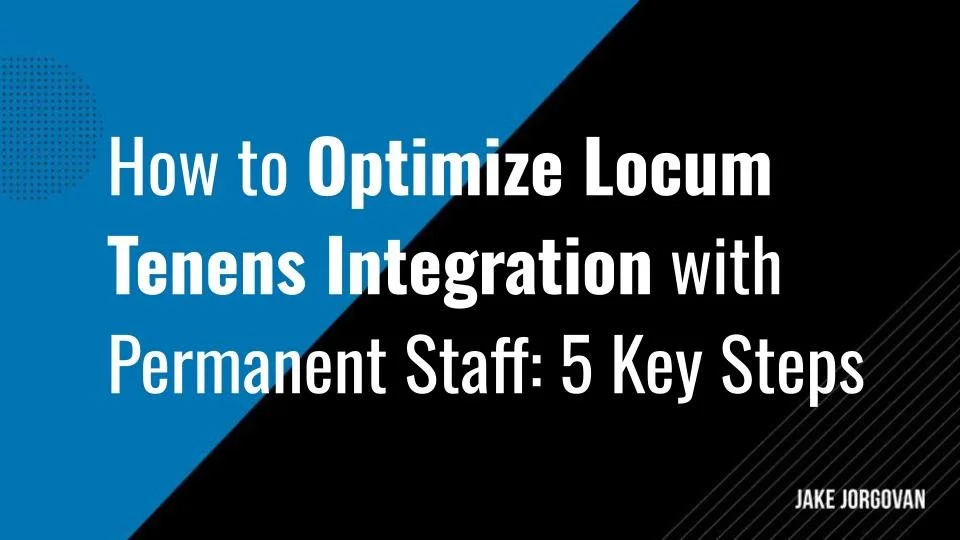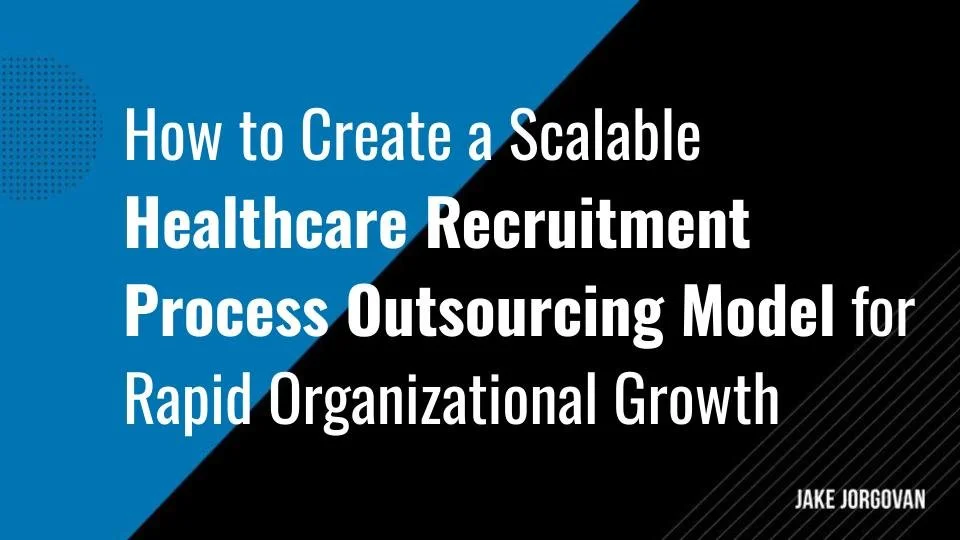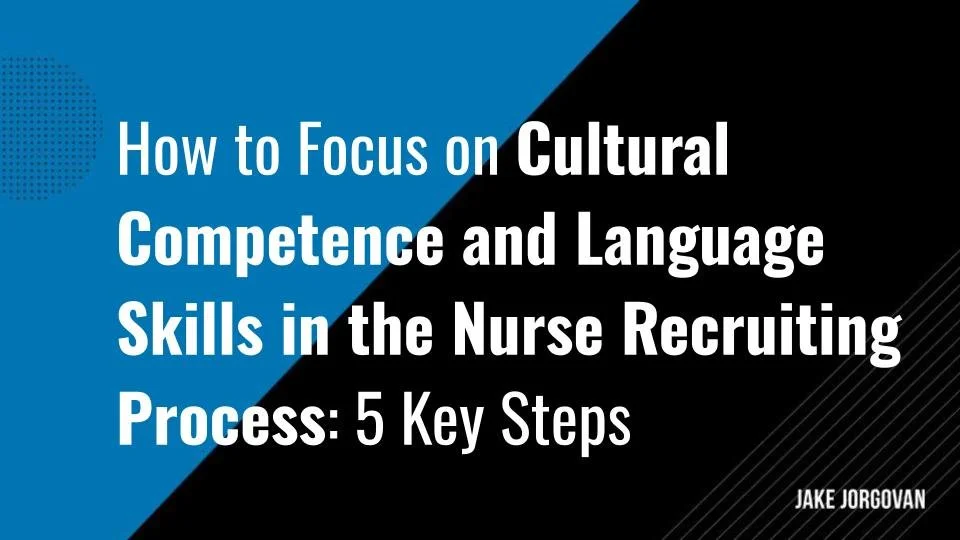How to Optimize Locum Tenens Integration with Permanent Staff: 5 Key Steps
Integrating locum tenens providers with permanent staff can be challenging but essential for a cohesive healthcare team.
Without proper planning, it can lead to disruptions and inefficiencies.
However, with the right strategies, you can turn this transition into a smooth process that benefits your staff and patient care.
This article outlines five key steps to optimize locum tenens integration to ensure collaboration and continuity.
Whether you're managing a short-term gap or expanding services, these steps will help you align temporary providers with your team's goals and culture.
5 Steps to Effectively Integrate Locum Tenens with Permanent Staff
1) Provide Thorough Orientation for Locum Tenens Upon Arrival
When integrating locum tenens professionals into your facility, proper orientation is critical to their success and the seamless functioning of your team. Locum tenens arrive with specialized knowledge, but understanding the nuances of your specific environment takes time. A structured orientation accelerates their adjustment and strengthens collaboration with your permanent staff. Here's how to set up an efficient, step-by-step orientation process:
Pre-arrival Information: Before they start, send locum tenens a detailed briefing on policies, staff structure, and relevant protocols. This ensures they have a foundational understanding and can focus on deeper operational matters on day one.
Dedicated Point of Contact: Assign a senior staff member or department lead to act as their go-to for any initial questions. This helps the locum feel supported while avoiding potential confusion from scattered input.
Comprehensive Facility Tour: Walk them through key areas, including patient wards, staff lounges, and essential medical supply locations. Knowing where everything is situated reduces downtime and fosters a sense of belonging to the team.
Technology and EMR Training: Schedule time for hands-on training with your Electronic Medical Records (EMR) systems and any other technological tools specific to your practice. Even if they’ve used a similar system, workflow differences exist. A smooth technology handoff prevents delays in patient care.
Shift Overlap with Outgoing Locum (if applicable): If possible, organize a short overlap between the outgoing and incoming locum tenens. This provides the opportunity for knowledge transfer and discussion of ongoing cases, improving continuity of care.
Insider Tip:
Having a clear, customized checklist for locums aligned with your practice's specifics—rather than generic guidelines—makes all the difference. We always recommend tailoring this checklist in collaboration with your clinical leads to ensure it addresses department-specific needs.
2) Promote Open Communication Between Locum Tenens and Permanent Staff
Effective communication between locum tenens and your permanent staff goes beyond casual interactions. It’s about ensuring that information flows seamlessly, which prevents gaps in patient care and creates a sense of collaboration. When communication breaks down, it impacts efficiency and the quality of care provided. To establish clear, structured communication:
Establish Clear Channels: Define specific communication platforms and protocols early. This avoids confusion over which tools to use for reporting patient updates or shift changes.
Daily Check-ins: Organize brief, focused meetings between locum tenens and key team members at the start of each shift. These allow for clarifying immediate priorities, sharing critical updates, and aligning on tasks for the day.
Clarify Roles and Responsibilities: Ensure everyone knows their specific duties, especially in high-stress environments. This step reduces overlap in tasks and keeps things running smoothly.
Set Feedback Loops: Create a system where locum tenens can give and receive feedback in real-time. Whether about clinical protocols or team dynamics, immediate feedback prevents minor issues from escalating.
Prioritize Patient Handovers: Require locum tenens to give detailed, structured handovers at the end of their shift. Handovers should include key patient information and potential red flags for the next clinician to address.
Insider Tip:
One communication pitfall is underestimating how critical the first 48 hours are. We always suggest scheduling a quick end-of-day debrief during those first two days to check for any communication issues and ensure that everyone stays aligned on expectations and workflows. This small step can prevent bigger problems down the road.
3) Assign Mentors or Buddies to Support Locum Tenens
Bringing locum tenens into your team requires more than just paperwork and protocols. They need a guide to navigate your facility's professional and cultural environment. Assigning a mentor or buddy can accelerate this process and make the locum’s integration more effective. Here’s a clear breakdown of how to make this system work to its full potential:
Choose the Right Mentor: Select a mentor who understands the facility’s operational workflow and has strong communication skills. A good mentor can ease the transition by answering questions and providing immediate context.
Define Mentor Responsibilities: Clarify what the mentor is expected to do. This may include introducing other team members, explaining unwritten rules, and serving as the first point of contact for any immediate concerns.
Schedule Regular Check-ins: Create scheduled opportunities for the locum and mentor to meet. A quick 10-minute check-in after a shift can highlight any issues, clarify procedures, and keep things on track without disrupting patient care.
Shadowing for the First Shift: If possible, arrange for the locum to shadow their mentor during the first shift. This is especially useful in high-pressure or fast-paced environments where learning in real-time matters more than theoretical briefings.
Monitor Progress Together: Set up a system for the mentor and locum to assess progress at the end of the first week. This allows both parties to highlight any ongoing concerns and address them early on.
Insider Tip:
Pairing a locum with a mentor from a similar specialty or department significantly improves integration. This leads to smoother communication, faster adaptation to procedures, and fewer misunderstandings during patient care. Always ask department heads to identify potential mentors who align with the locum’s specialty for optimal results.
4) Include Locum Tenens in Team Meetings and Social Events
Locum tenens may come and go, but integrating them into your team's social and operational fabric is critical for maintaining morale and continuity of care. Isolation or disconnect can occur if locums feel like outsiders, which impacts their performance and collaboration. Including them in team activities from the start bridges that gap and sets the tone for a more unified workforce. Here’s how to make that happen:
Invite Them to Team Meetings: Whether they are temporary or long-term, locum tenens should attend all relevant staff meetings. This keeps them updated on current priorities and ensures they feel part of the decision-making process.
Include Them in Social Events: Simple gestures, like inviting locums to after-work gatherings or casual team lunches, go a long way toward integrating locums into your team culture. It also helps them feel more comfortable communicating with permanent staff.
Create Opportunities for Informal Interactions: Design spaces in the workplace where locum tenens can engage in conversations with your staff during breaks or downtime. Casual, spontaneous chats help build rapport and trust.
Acknowledge Their Contributions: Publicly recognize locum tenens' efforts in meetings or team communications. This boosts morale and reinforces their importance within the team, making them feel valued.
Encourage Collaboration: During clinical rounds or collaborative tasks, actively involve locum tenens. Asking for their input or assigning them responsibilities that involve teamwork helps integrate them into the clinical flow.
Insider Tip:
Pairing locums with permanent staff on team-based projects creates natural opportunities for them to build relationships. We’ve seen how setting up shared goals between locums and core staff accelerates collaboration, making the integration process more seamless. Encourage department leads to assign group tasks whenever possible.
5) Standardize Procedures and Protocols for All Staff Members
Standardizing procedures and protocols for locum tenens is essential to maintaining consistent care quality across your practice. Without clear guidelines, locums may rely on their past experiences, which can lead to variations in patient care and operational efficiency. Setting up standardized processes ensures that all staff, temporary or permanent, follow the same framework, which minimizes errors. Here's how you can standardize these procedures effectively:
Create a Centralized Resource Guide: Develop a clear, accessible guide that includes all important policies, protocols, and workflows. Make sure this guide is available digitally and in hard copy so locum tenens can refer to it during their shifts.
Define Clinical and Operational Protocols: Outline critical protocols like patient admission, discharge, emergency procedures, and medication handling. Standardizing these ensures that locum tenens can jump into clinical care without needing to ask for instructions at every step.
Use Checklists for Critical Tasks: Provide checklists for key processes, such as patient handovers, surgical prep, or emergency response. These checklists should be designed to reduce variability in task performance.
Align Locum Onboarding with Standard Practices: Make sure locum tenens training or orientation covers all the standard protocols your permanent staff follows. This helps integrate them into the operational flow immediately.
Regularly Update the Guide: Keep your procedural guide current. Medical standards and facility policies change. Having an outdated resource can cause confusion and lead to procedural errors.
Insider Tip:
We’ve found that using digital tools to automate and standardize communication about protocols significantly reduces missteps. For instance, platforms that send automated reminders to locum tenens regarding new or updated protocols can prevent procedural drift. Always consider investing in systems that align locums with real-time updates to ensure they stay on track with current practices.
Help Locum Tenens Thrive Within Your Organization
Successful locum tenens integration is about maintaining a unified and efficient team.
As healthcare evolves, the role of temporary providers will only become more vital.
Applying these five key steps creates a foundation for seamless collaboration between locum tenens and permanent staff.
This thoughtful approach strengthens your team and enhances patient care.
The strategies you choose today will shape how your organization navigates the growing reliance on temporary healthcare professionals in the future.































